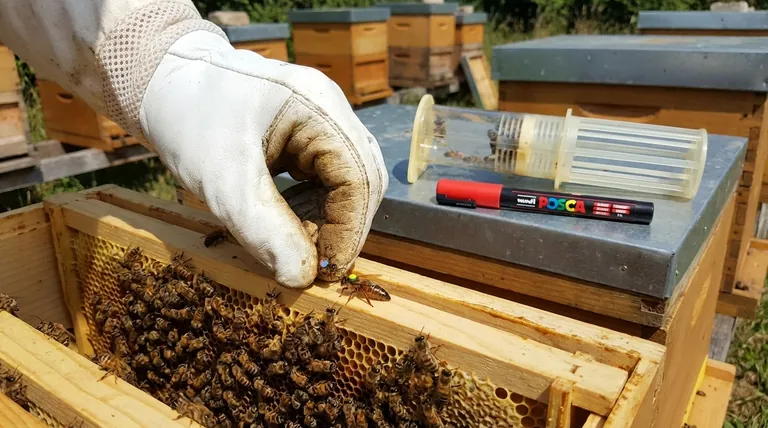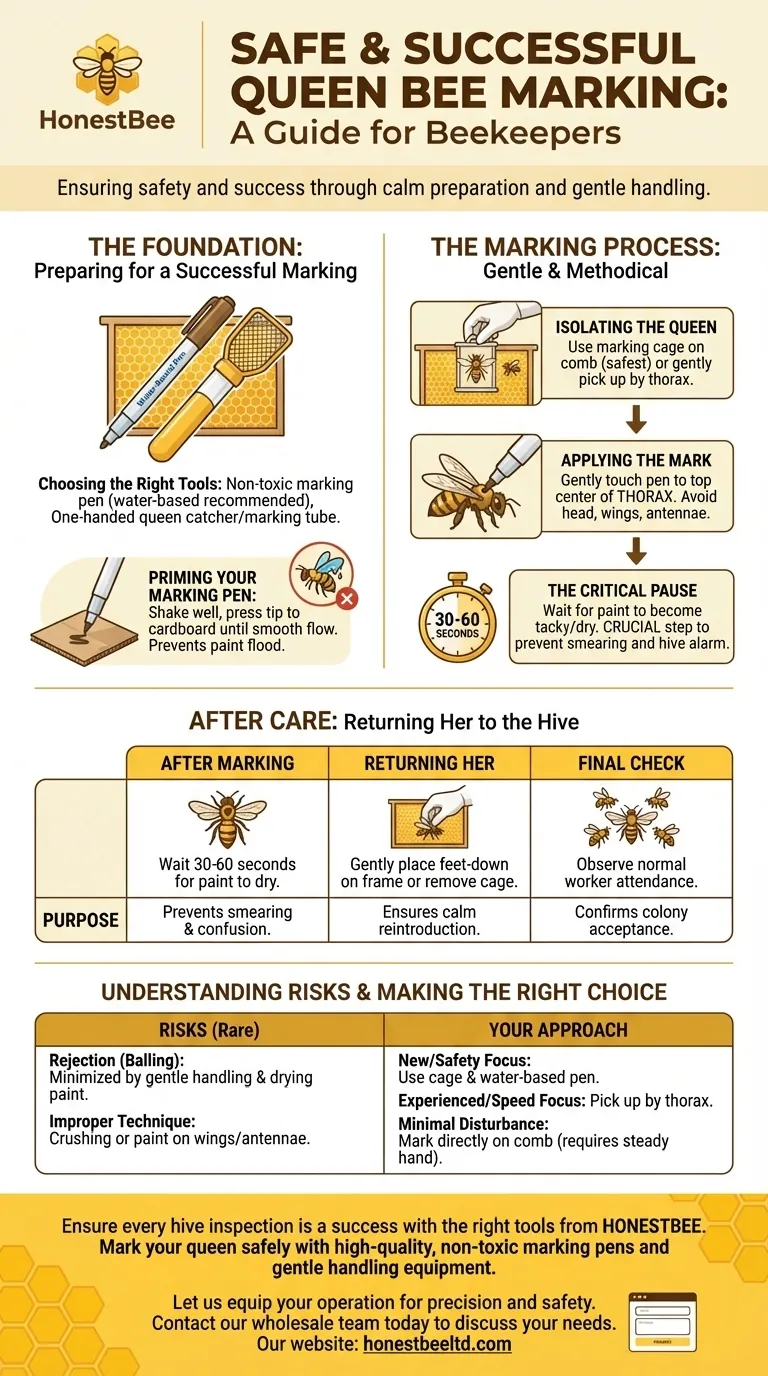After successfully marking your queen bee, the final step is to allow the paint a moment to set before carefully returning her to the hive. If you are holding her, gently place her back onto the frame. If you used a marking cage on the frame itself, simply remove the cage. Once she is back among the workers, you can slowly and gently place the entire frame back into the hive body.
The question isn't just what to do after marking the queen, but how to ensure the entire process is safe and successful. A successful marking relies more on calm preparation and gentle handling than on the final act of returning her to the hive.

The Foundation: Preparing for a Successful Marking
Before you even think about applying paint, proper preparation is the key to ensuring the queen's safety and minimizing stress on the colony.
Choosing the Right Tools
The most critical tool is a high-quality, non-toxic marking pen. For new beekeepers, water-based paint pens are highly recommended as they are very safe. Experienced keepers often use solvent-based pens for their durability, but both work well.
A one-handed queen catcher or a marking tube is also invaluable. These small cages allow you to safely immobilize the queen on the comb without having to pick her up, drastically reducing the risk of accidental injury.
Priming Your Marking Pen
Never use a new pen on a queen without priming it first. Shake the pen well, then press the tip onto a piece of cardboard or paper. This retracts the nib and saturates it with paint. Repeat until you have a smooth, consistent flow.
This step prevents the pen from releasing a flood of wet paint onto the queen, which could cover her wings or breathing spiracles.
The Marking Process: A Gentle and Methodical Approach
Your movements should be slow, deliberate, and calm. The bees will respond to your energy.
Isolating the Queen
Once you locate the queen, you have two primary options. You can either gently pick her up by the thorax (never the abdomen) or use a marking cage to press her lightly against the comb. For most beekeepers, the cage method is safer and easier.
Applying the Mark
With the queen immobilized, gently touch the pen to the top center of her thorax—the hard-shelled middle section of her body. Do not apply pressure. A properly primed pen will leave a perfect dot of paint with a simple touch.
The goal is a small, clear dot. Avoid getting paint on her head, wings, or antennae.
The Critical Pause
After applying the mark, wait 30-60 seconds for the paint to become tacky or dry. This is a crucial step. Releasing her immediately can cause the paint to smear onto her wings or onto other bees, which can cause confusion or alarm within the hive.
Returning Her to the Hive
If you are holding her, gently place her feet-down onto the top of a frame. If you used a cage, simply lift it off. Watch for a moment to ensure the worker bees attend to her normally, then slowly return the frame to its position in the hive. The job is now complete.
Understanding the Risks and Trade-offs
While marking is a standard and safe beekeeping practice, it is not without minor risks. Understanding them allows you to mitigate them effectively.
The Risk of Rejection ("Balling")
Very rarely, the scent of the paint or stress from handling can cause worker bees to perceive the queen as a foreign intruder. They may attack her in a process called "balling." This risk is minimized by using a minimal amount of paint, allowing it to dry, and handling her as gently as possible.
The Danger of Improper Technique
The greatest risk comes from poor technique. Applying too much pressure can crush the queen, while getting paint on her wings or antennae can impair her movement and communication. This is why preparation and calm handling are paramount.
Marking is a Tool, Not a Requirement
Remember that marking a queen is a management technique, not a necessity for a healthy hive. It simplifies inspections by making her easy to find, but many successful beekeepers choose not to mark their queens at all to ensure zero risk.
Making the Right Choice for Your Goal
Your approach should match your experience level and goals for the hive.
- If your primary focus is safety and you are new to the process: Use a one-handed queen catcher and a water-based pen to eliminate direct handling and ensure a gentle application.
- If your primary focus is speed and you are an experienced beekeeper: Picking the queen up by her thorax is efficient, but only if you are confident and calm in your handling.
- If your primary focus is minimal disturbance: Marking the queen directly on the comb without a cage is possible, but it requires an exceptionally steady hand and a calm colony.
Ultimately, a properly marked queen is a valuable asset that empowers you to manage your colony with greater confidence and precision.
Summary Table:
| Step | Key Action | Purpose |
|---|---|---|
| After Marking | Wait 30-60 seconds for paint to dry | Prevents smearing and bee confusion |
| Returning Her | Gently place her feet-down on a frame or remove the cage | Ensures a calm reintroduction to the workers |
| Final Check | Observe worker bees attend to her normally | Confirms colony acceptance before closing the hive |
Ensure every hive inspection is a success with the right tools from HONESTBEE.
Marking your queen safely requires high-quality, non-toxic marking pens and gentle handling equipment. As a trusted supplier for commercial apiaries and beekeeping equipment distributors, HONESTBEE provides the durable, beekeeper-tested supplies you need for confident colony management.
Let us equip your operation for precision and safety. Contact our wholesale team today to discuss your needs and browse our full catalog of reliable beekeeping solutions.
Visual Guide

Related Products
- Queen Bee Marking Pen POSCA Queen Marking Pens for Beekeeping Bee Markers
- Queen Bee Marking Pen UNI Medium Point for Queen and Bee Marking
- Plastic Queen Marking Tube Cage with Plunger for Beekeeping
- Professional Engraved Round Hive Number Tags for Beekeeping
- Heavy Duty Stainless Steel Queen Bee Catcher Clip
People Also Ask
- What type of markers are commonly used for marking Queen bees? Choose the Safe, Non-Toxic Standard
- What are the benefits of marking a Queen bee for hive management? Boost Efficiency & Colony Health
- What is the purpose of a queen marking pen in beekeeping? Essential for Efficient Hive Management
- What are the benefits of learning to mark your own queen bees? Boost Your Apiary's Efficiency and Confidence
- Where is the queen bee typically marked? A Guide to Safe & Effective Queen Identification



















